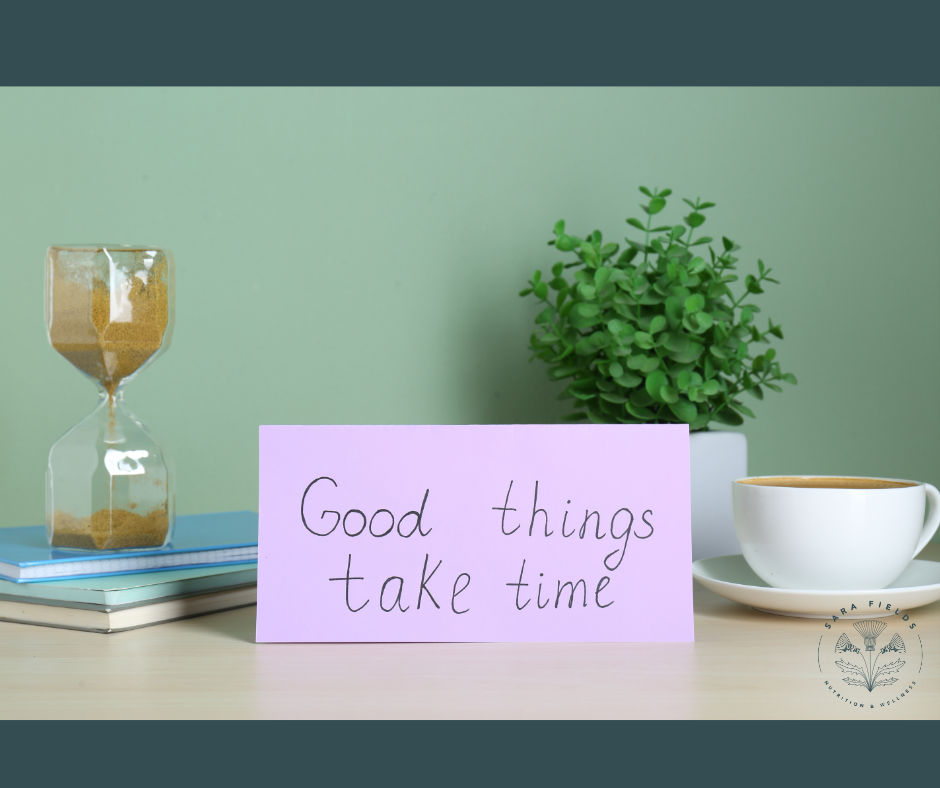
Okay, let’s start with the elephant in the room—I kind of hate using the word “sexy” in contexts like this, but bear with me because it really nails the point.
Healing protocols, diet changes, lifestyle shifts—they’re not sexy. There’s nothing glamorous about committing to daily habits. They can feel monotonous, especially in a world where instant gratification reigns supreme. But here’s the thing: healing takes work and it takes time—and staying the course is what ultimately gets you where you want to be.
Healing Happens on Body Time, Not Your Time
Before we dive into the challenge of change and what we can do about it, it’s important to understand that our bodies operate on natural cycles of cell regeneration and system repair.
Intestinal cells regenerate every five to seven days, but repairing gut damage from inflammation or infection can take months.
Skin cells renew about every month, so it can take six weeks or more to see visible improvements.
Lowering glucose or cholesterol can start within weeks, but significant improvements often take months of sustained effort.
Restoring hormonal balance may require 3 to 6 months of consistent support and lifestyle changes.
Knowing this – that the body follows its own schedule and improvement in symptoms doesn’t happen overnight – can help you establish more realistic expectations for your timeline. Ultimately, it requires patience and consistency to heal.
Why We Struggle to Stay Committed
So, why do we fall off the wagon so easily?
It comes down to human nature, my friend, and to two key ideas: immediacy and novelty.
We live in a world where we can get everything we want instantly—fast food, the answer to a question with a quick web search, or next-day delivery. My husband and I often talk about how our kids will never understand watching shows with commercials or having to wait until the next week for another episode of your favorite show… much less recording it on VHS if you were going to miss it! (I really dated myself with that one, huh?)
This conditioning spills over into our health, where we expect results just as quickly, and when the results don’t come fast, we start telling ourselves, “I don’t have time for this,” or “Nothing is changing, so why bother?”
And then there’s what I often refer to as “Shiny Object Syndrome”. We get bored, y’all! We jump from one new promised solution—a new diet, a cure-all supplement, a fancy protocol—to the next because each one triggers a release of dopamine—our brain’s way of rewarding us for novelty. But then, after a while, the excitement wears off, and you’re left with… well, just doing the work.
And long-term healing requires exactly that—doing the work! Long obedience in the same direction. I’m taking that Nietzsche quote totally out of context, but you get the idea. It’s about laying down those habits brick by brick, even when it feels boring, even when you can’t see the results right away. And when you resist the temptation to jump ship, what you’re actually building is balance, emotional resilience, and TRANSFORMATION!
Why This Doesn’t Serve Either of Us
If you stop part way through or only halfway invest in the process, what happens? Maybe there’s more frustration, more overwhelm, more hopelessness because yet another attempt at a solution has failed. This reinforces that sense of defeat and makes things harder. Not only are you stuck in the same place, but what is that preventing you from doing or having in your life?
And I know it’s not about me here, but my entire mission is to make the world a better place one person at a time. I want to help you find more joy, energy, and vitality so that you can pass that positivity on to the people in your life. The butterfly effect, right? One person changes, and that change ripples outward. So, selfishly, it doesn’t serve me either when you don’t stick with the plan and get the transformation I know is possible. 🙂
How to Override the Urge to Quit
So how do we fight this natural urge to bail when the going gets tough or we’re just straight-up bored? It starts with mindset, but you can also take practical steps to keep yourself committed.
- Revisit your why: Why did you start this journey in the first place? Was it to have more energy, clearer skin, or better digestion? And if you accomplished those things, how would your life be different? Get really clear on this and remind yourself what’s at stake if you go back to your old ways. Stay connected to the bigger picture.
- Set small, achievable goals: It’s not about the end result right away. Focus on little goals, like drinking more water or prepping meals for the week. Celebrate those small wins—they’re building blocks.
- Create accountability: Tell someone your goals. Whether it’s a friend, a support group, or your Nutritional Therapy Practitioner and Health Coach (wink, wink!), stay accountable to someone other than yourself. Knowing someone is cheering you on keeps you motivated.
- Embrace the monotony: Instead of resisting the daily grind, reframe it as progress. Every meal you prep, every night of good sleep, and every supplement you take is one step closer to your goal. Remember, healing is a marathon, not a sprint.
- Talk back to the excuses: As Gay Hendricks says in the book “The Big Leap”, this is an upper-limit problem. Recognize the excuses your brain is making to keep you in your comfort zone. “I deserve a break,” or “Maybe there’s something quicker that works better” are common thoughts that derail progress. When they come up, counter them with your commitment – go back to #1 on this list and remind yourself of your “why”.
- Be kind to yourself: You’re human, and the process won’t be perfect. There will be bumps in the road, but that’s part of the journey and it’s a wonderful opportunity to learn more about yourself. Give yourself grace when things don’t go exactly as planned, and get back on track when you can.
It’s Not Always About the Big Leap, But the Small Steps
You’re likely reading this because you’re either at the start of your health journey, or you’re already on it and might be struggling to keep up the momentum. Remember: this stage, where the excitement fades and routine sets in, is completely normal.
This process isn’t just about getting to the finish line. It’s about learning how to care for yourself and build a foundation for long-term wellness. The challenges you face now are part of your growth, and the transformation you’re seeking is already in motion, even if you can’t see it yet.
If you’re ready to take the next step toward a healthier, more vibrant life, I encourage you to fill out an application to work with us so we can create a transformative health strategy with you.
And if you aren’t ready for that, take those six steps above today. You’ve got this.

leave a comment